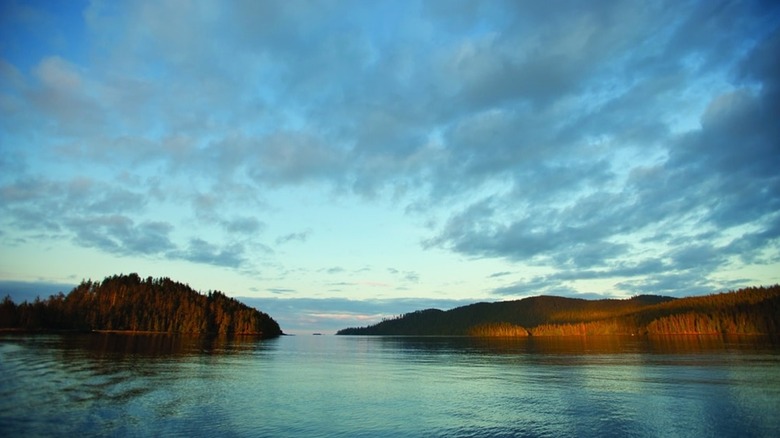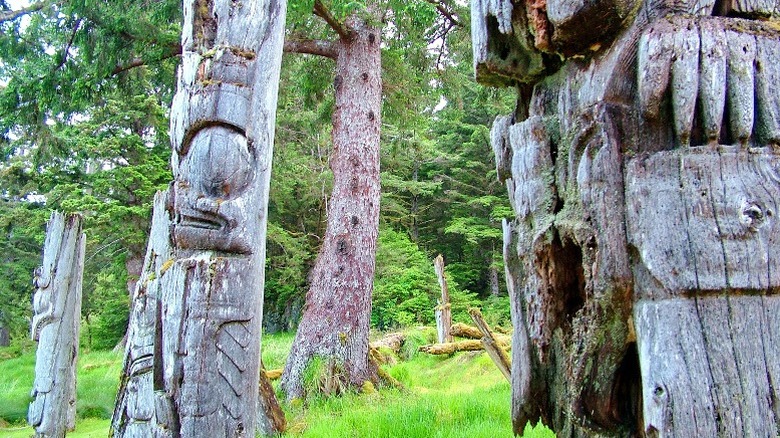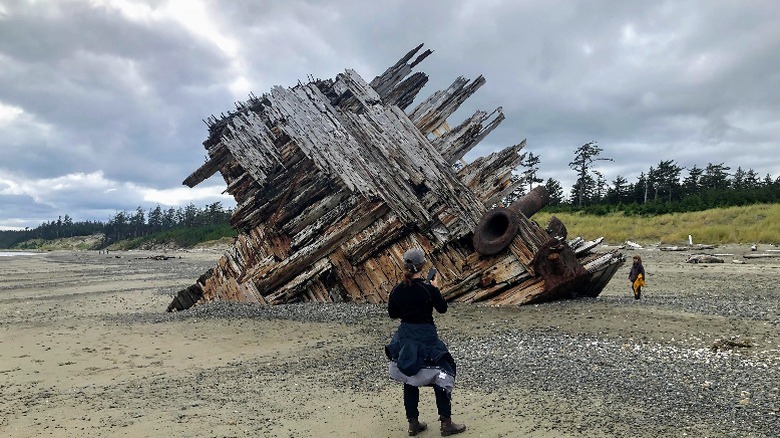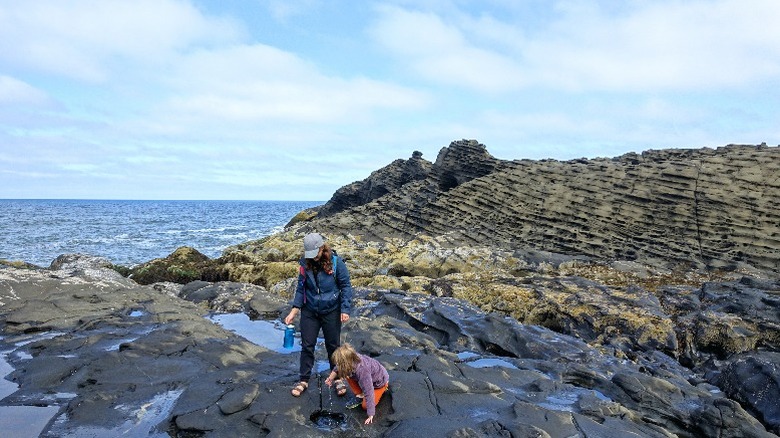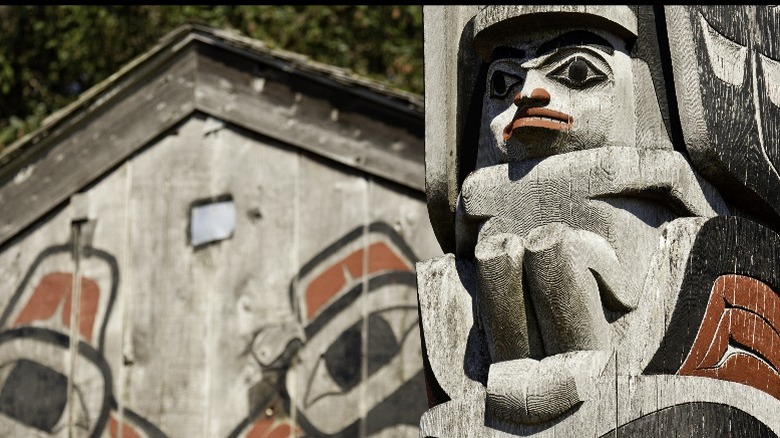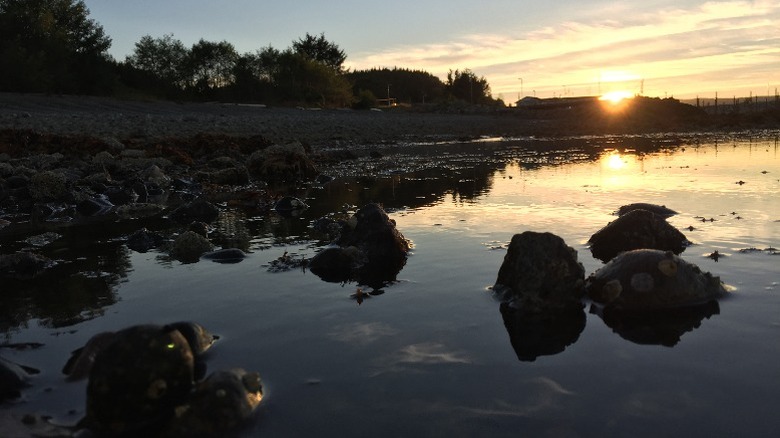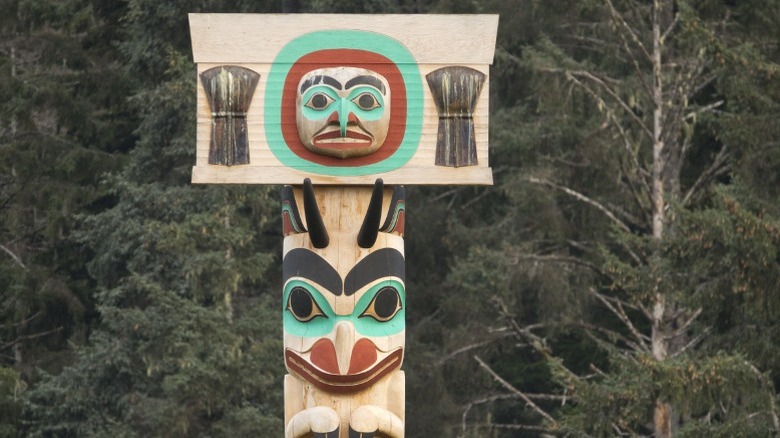Why You Should Travel To Haida Gwaii, Canada
I really shouldn't be here in this plank longhouse. Watching Christian White deftly carve a totem pole. Standing near his daughters dressed in rarely-seen potlatch regalia. Just 60 years ago, Christian and I could have been imprisoned for this, and the girls were exiled to boarding schools. This is why I'm here on Haida Gwaii, 130 miles from Vancouver Island: To find out how these people came back from the brink of extinction. The answer is right in front of me.
A wet wind moans against the thick walls of the longhouse. Inside, where you might expect to see pictures or newspaper clippings, there are instead rare handcrafted canoe paddles and dance masks. Christian cleans a knife blade with his fingers and gazes out at the gray sea. "On a clear day, you can see Alaska."
On this day, though, there's nothing in view but a row of pastel houses facing the mist. Crab pots and outboard motors clutter the yards, and yellow fishing bibs drape the decks. This is Old Massett, one of two Haida villages left in the islands. The others fell to epidemics that wiped out 90 percent of the people. What smallpox had started with the Haida people, the Canadian and American governments were determined to finish. As recently as 1951, the heart of Haida culture, the potlatch ceremony, was still banned. "Uncivilized," they called it. The Haida language was forgotten. Haida art, like this totem, was heaped into bonfires to erase every last vestige of Haida identity.
The totems
So I find it momentous to stand with a totem in a fresh pile of wood shavings. When the government crackdown ended in 1951, the pole became a rare and iconic symbol of the Pacific Northwest. And while collectors would pay hundreds of thousands of dollars for a totem like the one Christian is carving, it isn't for sale. It's far too valuable. "When I'm done," he says, "I'll take it to a hidden location deep in the forest. I'll raise it at an ancestral site."
I'm among a handful who will ever see the priceless totem, which in a short time will be abused by the harsh weather. This makes the poles temporal, with a life span of 70 to 100 years. I can't help but think how contradictory this is to their purpose of documenting and preserving history. The Haida have no written stories. The carvings remind them of who they are and where they came from. Of what was almost lost.
"People come and see old totem poles cracked and falling down," says Christian. "They want to clean the poles to appreciate them. But in doing so, they miss the point. The poles look exactly as they should. When one falls, you let it fall. If totem poles lasted forever, maybe no one would ever be inspired to make new ones, and a big part of our culture would be lost." This necessary act of constant creation is what keeps the modern Haida alive. What Western eyes see as the ravages of time and the elements, they see as a state of grace. "Why fight time?" says Christian. "Live in the now."
Now. It's a hard concept. I'm a product of my own culture, one that dwells on the past and frets about the future. We hoard and save. When it comes to art, we're fanatics. We put the Mona Lisa in a sealed, vibrationproof box behind bulletproof glass in a roped-off alcove in a humidity-controlled museum. And no one has painted anything like her in the past 500 years. It's not just art or things, either. What about Botox? A face-lift?
Learning to live in the moment
"So, what's the secret? How do the Haida live in the moment?" I ask. I'm hoping for an easy answer. Instead, I get a quest. "You need to see SGang Gwaay," Christian says.
SGang Gwaay ("Skung Gwhy"). Wailing Island. The most isolated island, on the stormiest edge of the Haida Gwaii archipelago. Raked by hurricane-force winds and drowned in 15 feet of annual rainfall. There are no roads to it, no airports. There's only one way to SGang Gwaay.
Haul away on The main halyard!" shouts Neil Shearar. He's skippering the impressive 92-foot Maple Leaf, British Columbia's oldest tall ship. Wearing a roll-neck Aran sweater and foul-weather bibs, Neil is straight out of an Old Spice commercial. The sails rise in snapping flaps like broncos bursting from the gate. Then they boom taut in the wind.
The sun is out, and the eight other passengers on deck are glassing the sea for whales. They're all Canadian and British. There are Hélène, a Supreme Court judge; Trevor and Craig, two buddies on an adventure; and Gail, a young schoolteacher on holiday. All are well-traveled; some have sailed aboard the Maple Leaf before. The one thing we all share is our foremost reason for coming: to set foot on SGang Gwaay. Few Haida and fewer outsiders have been there. The island is well guarded by unpredictable weather, and both the island and the sea are deeply respected by all people of the archipelago, including Capt. Neil. He tempered our dreams when we boarded the boat at a logging camp. "We'll try to get to SGang Gwaay," he said, "but I will not promise anything."
The exploration that awaits
Still, there's a wild joy in traveling this far south through the roadless wilderness of southern Haida Gwaii. At Hotspring Island, we stop to plunge into the freezing sea and then luxuriate in natural thermal pools. At the old Rose Harbour whaling station, an off-the-grid guitarist with a Santa Claus beard plays "In the Hall of the Mountain King" outside a brightly painted cabin. Eagles pipe from snags leaning over the water. I stop counting humpback and fin whales when I get to 100. The waves are wine-dark with krill, so the first mate scoops up a netful for the chef to saute with garlic.
As we move through an estuary on a Zodiac, Neil spots a black bear patrolling the beach. Neil kills the engine, and we drift. In Haida mythology, there is no line between humans and animals, nor the natural and supernatural. To the Haida, this bear is just another Haida in bear clothing out hunting for crabs. We view each wildlife encounter with awe while constantly anticipating what's next. The animals, I realize, are just the opposite. They're always in the moment. Next week's food bill is of no concern because the shores are a supermarket. One Haida woman I'd met in the village of Skidegate joked that all the food they need comes from the waterline. "When the tide is out," she said, laughing, "the table is set."
The Haida's DNA has always held the memory of the seasons when to catch salmon and halibut, where to hunt caribou and geese, and where to find wild berries. The abundance made the nation wealthy and enabled it to survive even when others didn't want it to. Living in the present tense. The bear eventually ambles back into the forest shadows on this island still far from SGang Gwaay.
An opportunity for introspection
Neil fires up the Zodiac's motor to take us back to the Maple Leaf so we can sleep before making a final run to the life-changing island. He glares at the sun. It looks strange, encircled with a bright halo and two glowing stars on either side. "Sundogs," Neil says gruffly. "That means a change in the weather. And not for the better." I slept poorly that night, tossing and turning, thinking of tomorrow. Will the weather allow us to make sure on SGang Gwaay? What's so well-guarded on that island? And when insomnia leads me out on deck, the stars are gone, and a rising wind cools my cheeks.
The island is right here, but I can't see it. SGang Gwaay is hidden in fog. We creep through silky kelp beds on the Zodiacs, which now seem like Haida war canoes. We arrive on a beach. No one speaks. Standing in front of us, in sight now, are rows of totem poles. It's like a rainforest version of Easter Island. They're gray and fat as Roman columns. Most have been blasted down by the wind and rain, with piled chunks of rotted wood at their bases.
I'm wondering if we belong here. I linger behind the group, transfixed by a tall pole. "She's the Bear Mother, my favorite pole," a voice says. I turn to meet James Williams, the head watchman. He has a New York Yankees cap pulled low on his brow and his red jacket zipped up to his chin. "She's a mortuary pole," he says, pointing at a cavity on the crown. "Once a chief's bones are placed there, his spirit is part of the pole. The spirit isn't released until the pole falls." Over the next few hours, James shows me around the old village. We walk past grassy depressions that were chiefs' homes. Deeper in the forest, James kneels down and delicately peels a blanket of moss from one of the many fallen trees. A face stares up at us. All these trees on the forest floor, I realize, are sleeping totem poles.
Making the past part of the present
"It's part of the life cycle," James says. "After 80 years, like our life span, the poles fall and return to the forest." James covers the face back up. My instinct is to save at least one of these poles lying in the forest. Not James'. "How do you do it?" I ask. "Making the past part of the present?" "Come back when it's dark," James says. "I'll show you."
That evening when twilight falls into a cold blue night, I join James and two other watchmen as they burn driftlogs in a bonfire on the beach. I'm not supposed to be here. Visiting hours are strictly regulated. But James has made an exception because he wants me to see something that will help me understand the connection between the past and the present. Not far from the fire is the Bear Mother pole.
"Every year, I notice different pieces falling off," James says. "I know the chief is on his way out. He must be getting tired, holding on so hard." It's too mystic for me, so I press James a little further. "There's more to it than that, isn't there?" He nods and stares quietly into the fire for a few minutes. "Bear Mother reminds me of my family, of happier times," he says. "The bear is my mother, the cubs are my brother and I. Our mother is holding us close to her."
He kicks an errant coal back into the fire. "She was killed by a drunk driver when I was 12." Sparks trail up the sky. James turns on an iPhone, and a Haida song rises with the smoke. He looks up at the half-dozen poles watching us. The reflections of the flames are dancing on their weathered faces. They look alive. "It's times like this that make me realize we made it, you know," says James. "That we didn't drop off the face of the Earth, that the Haida are still here. I'm still here."
A trip to remember
I think back to the scent of freshly shaved cedar in Christian White's longhouse and the pole he'll hide in the forest. I think of the face in the forest beneath the moss. The totems are beautiful, and all the more so because their lives here, like ours, are impermanent. Before I left Old Massett, an archaeologist told me I'd better hurry to see SGang Gwaay before the poles fall. But down here by the fire, I know he's wrong. I could be here five years from now. Ten. Fifty. It wouldn't matter. The time to be here would always be now.
